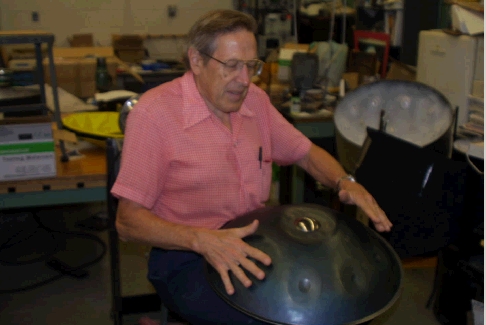Thomas D. Rossing - Rossing@physics.niu.edu
Physics Department
Northern Illinois University
DeKalb, IL 60115
815-753-6493
Uwe J. Hansen - Phhanse@scifac.indstate.edu
Department of Physics
Indiana State University
Terre Haute, IN 47809
812-237-2046
Felix Rohner and Sabina Schrer - postmaster@panart.ch
PanArt
Engehaldenstrasse 131
CH-3012 Bern, Switzerland
Popular version of paper 2aMU5
Presented Tuesday morning, December 4, 2001
142nd ASA Meeting, Fort Lauderdale, FL

One of the authors (Rossing) playing a HANG.
The HANG is a new steel percussion instrument, consisting of two spherical shells of steel, suitable for playing with the hands. Seven to nine notes are harmonically tuned around a central deep note which is formed by the Helmholtz (cavity) resonance of the instrument body. The instrument is generally held in the player's lap and played with the hands, although it can also be played with soft mallets. By changing the position of his/her knees, the player can change the deep note and vary the timbre of the instrument while playing.
The HANG was developed by PanArt in Bern, Switzerland, a firm that has also developed the PANG family of steel instruments, based on the familiar Caribbean steelpans of Trinidad. The PANG family of steel instruments were the first to incorporate nitrided or sandwich-hardened steel. This same material gives the HANG great durability.
Seven to nine elliptical note areas are formed on the upper shell of the HANG and tuned so that the principal modes of vibration in each note area have frequencies that are in the ratios of 3:2:1 with respect to the fundamental, except in the highest notes where they are in the ratio of 2.5:2:1 or 2.4:2:1. Holographic studies show the modal shapes and also the extent of coupling between note areas.
The holographic interferograms below show the first five modes of vibration in one note area (G3) of the HANG. In the fundamental (0,1) mode the entire note area moves in a single phase. Next are a pair of (1,1) modes with a nodal line crossing the center of the note area, while a pair of (2,1) modes have two nodal lines across the note.
The Caribbean steelpan is probably the most important new acoustical instrument to develop in the 20th century. Since its invention in Trinidad some 50 years ago, improvements in the technology and design have resulted from research in Europe and the United States in addition to its home country of Trinidad and Tobago. It has also inspired the development of new steel instruments, such as the PANG family of instruments and the hand-played HANG.
